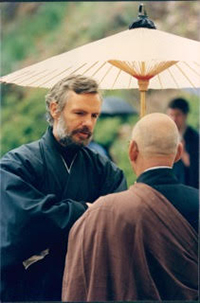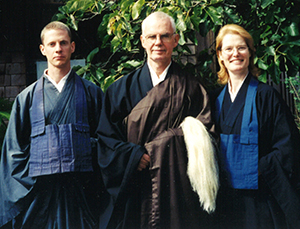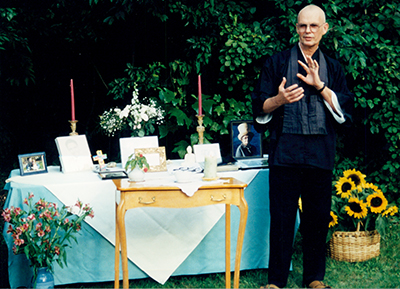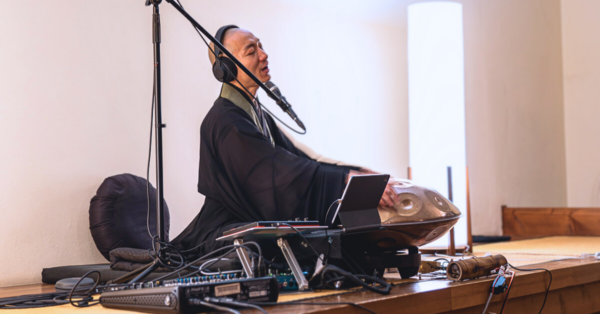 Seido Eishu Lee de Barros
Seido Eishu Lee de Barros
Clear Path, Constant/Endless Effort
November 5, 1936 – March 6, 2019
“Let your practice be a celebration of life.” —Seido Lee deBarros
Seido Eishu Lee Lüssen deBarros passed away peacefully on March 6, 2019, surrounded by family, friends, and sangha.
Lee was ordained a Soto Zen priest in 1989 at Green Gulch Farm by Sojun Mel Weitsman, receiving the Dharma name Seido Eishu, “Clear Path, Constant/Endless Effort.” He received Dharma Transmission at Tassajara in 1998 from Zoketsu Norman Fischer.
Lee was a long-time meditator whose practice was first influenced by the teachings of Eknath Easwaran. Along with his wife, lay Zen teacher Martha deBarros, he lived for over ten years at Green Gulch Farm and Tassajara. He filled senior staff roles at Green Gulch and served as tanto (head of practice) at Tassajara.
In 1999, responding to a call from inmates interested in starting a Zen group, he founded the Buddhadharma Sangha inside San Quentin State Prison. He went on to serve diligently and with great heart as the Sangha’s Head Teacher until his retirement in 2015. Since the day Lee founded it, the San Quentin Sangha has met nearly every week, bringing the lineage of Dogen Zenji and Shunryu Suzuki Roshi behind the prison walls and touching the lives of hundreds of inmates and volunteers.
Lee conferred the Bodhisattva precepts on many Zen students, including over thirty inmates and several non-inmates lay ordained inside San Quentin over the course of four jukai (lay initiation) ceremonies between 2002 and 2015. He performed one priest ordination, for Jiryu Rutschman-Byler, held at Green Gulch Farm in 2002.

Lee at San Quentin
Lee was deeply involved in and much beloved by the Marin County Interfaith community. He was active in the Marin Interfaith Street Chaplaincy, serving as street chaplain, board member, and eventual board chair, and also in the Marin Interfaith Council, where he served on the board. In addition to teaching at Green Gulch Farm and San Quentin, he taught regularly at Dharma Eye Zen Center, Dominican College, and the Redwoods Retirement Community.
Lee was born on November 5, 1936, in Brooklyn, NY, the son of Leo and Catherine deBarros. He grew up in lower Manhattan and Rye, NY, and attended Harrison High School and Rensselaer Polytechnic Institute. In his youth, Lee developed a reputation as an accomplished chess player and, after overcoming polio, became an excellent tennis and basketball player. At 20, he relocated to Pasadena, CA, and then moved north to attend graduate school at University of California at Berkeley. He spent time working as an elementary school teacher, and in the 1970s and 1980s served as the senior director of Marin County Rehabilitation Services. He is survived by his wife, son, three stepchildren, and six grandsons.
He was an avid birder, reminding friends and family, “If you are feeling lonely, fill the bird feeder.”
As Norman Fischer put it, “Lee was a true priest and a good one. He liked to keep things light and modest but underneath that was a fierce and deep spirituality.”
A memorial for Lee will be held at Green Gulch Farm at 4:00 pm on April 27, 2019. If you plan to attend, please RSVP at Evite.
These are a few of Lee’s Dharma Talks given at Green Gulch Farm:


Lee with Sojun Mel Weitsman

Jiryu Rutschman-Byler, Lee, Christina Bryant at Old Fig Zendo 2001













I feel eternal gratitude for having had the opportunity to experience the light and being able to sit at the feet and learn from such a compassionate being.
His work at San Quentin firmly put me on the path
Dear Lee was one of those people that I had an immediate affinity with. We practiced together at Green Gulch and Tassajara where I had long conversations with this sincere, highly motivated seeker. He had a great loving heart that was easily expressed through his ever ready smile. It was easy to ordain him, as in his heart and in his practice he was already fully committed. It was also easy to find his name: Clear path /Endless (constant) effort.
It was a pleasure to perform Lee and Martha’s wedding. After I was no longer abbot at Zen Center in the late 90’s we were pretty much out of touch. Now that he is gone, I feel the loss, and how nice it would be to sit down again and have a cup of tea and a nice leisurely conversation interrupted occasionally by “Did you see that bird?”
Lee’s activism as a Zen Priest was a natural fit with his life-long dedication to being of service. Likewise his easy-going style, usually interspersed with humor, was a delight to be around and yet it belied his unswerving and deep commitment to the Buddhaway.
Seido Lee deBarros was a friend yet also an instructor (“seido” is a title of respect in Zen). The San Francisco Zen Center describes him as “a Dharma teacher in the Suzuki Roshi Soto Zen lineage. He serves as a Buddhist chaplain at San Quentin prison and is a minister to the homeless and to hospice patients.” His wife Martha initiated the Zen Hospice Project in San Francisco in 1986. Martha and Lee have been planting and growing compassion together for many seasons.
Lee was one of my dearest friends and mentors at Green Gulch. I started going into San Quentin with him almost right away, in 2000. I feel deep gratitude for his deep and solid friendship, unpretentious teaching style, care and laughter. Deep bows.
Lee will be deeply missed. We worked together with the Marin Interfaith Street Chaplaincy when I was chaplain for ten years and he served on our board. We also taught several classes together. A good man and fine friend.
I wrote this memorial tribute to Lee for my weekly column in NC:
https://www.citizen-times.com/story/life/2019/03/15/highland-views-smile-breath-and-bow-buddhist-priest/3142109002/
In the 1980s Lee was my boss for many years at a drug rehab center in Marin. As a new employee he helped me feel included. He gave me lots of time, listening to my uneducated ideas of how to get our clients sober, then encouraging me to try my cockeye methods. AND then Lee would tell me to read his favorite book about how addiction is a spiritual issue, lacking the feeling of belonging, even to ourselves.
Lee walked his talk with the clients by not treating clients as “others”. He would spend long periods of time sitting down with ravaged men and women in the center’s smoky living room, listening, laughing and encouraging them to try a different and healthy path. He was a good teacher.
Years later when I heard he found Green Gulch and the prison project I was delighted. I knew he was in the right place. I am glad our karmas and paths crossed in 1986 or I might not have studied the dharma. Thank you for posting this.
Whoops. It was the early half of 1980 not 1986.
I had the privilege of meeting Lee in my 20s when he was a visiting summer teacher at Tassajara. Though he held the role of a teacher, there was no pretense about him—just a genuine, grounded presence. Of all the teachers I’ve ever had dokusan with, Lee is one who stumped me with a Dharma question that still echoes in my mind today—a moment that has stayed alive and evolving within me. Thank you, Lee, for the questions that linger.